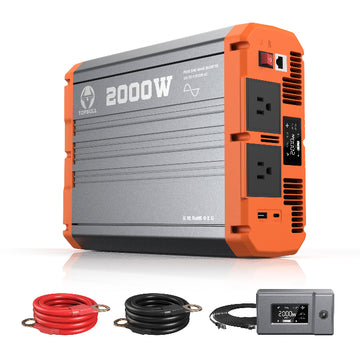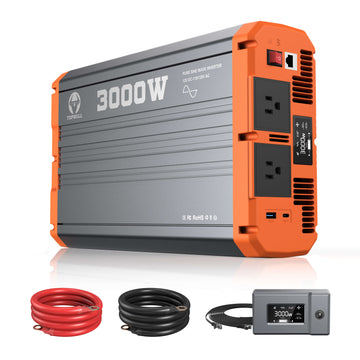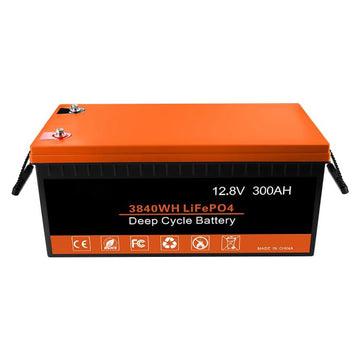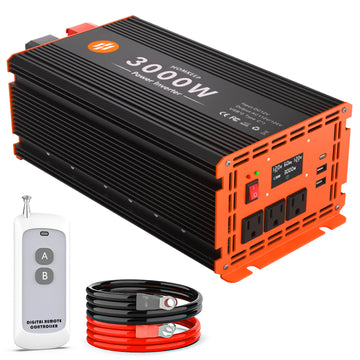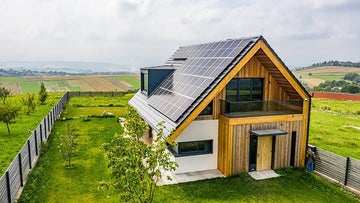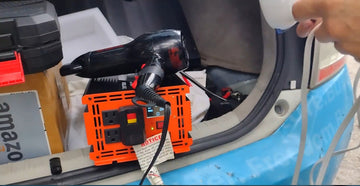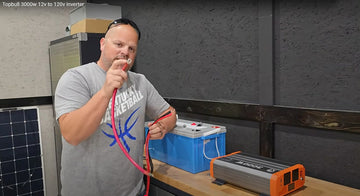Inverters are essential for providing stable AC power to a wide range of devices, including household appliances and solar power systems. However, many users neglect to consider critical factors when selecting an inverter, which can result in increased costs, performance issues, and even damage to the appliance. This article will identify the most common inverter selection mistakes and provide actionable strategies to help you make an informed decision.
Why is inverter selection important?

Role of inverters in power systems
Most electrical equipment and appliances rely on alternating current (AC) to operate, while energy storage devices such as batteries and solar panels typically generate direct current (DC). The main function of an inverter, an essential core component of a power system, is to convert DC to AC. In addition to converting power, inverters must ensure that the output voltage and frequency are stable to meet the needs of various loads.
The waveform of the inverter's output determines the type of load it is suitable for:
- Pure sine wave inverters: provide AC power closest to grid quality and are suitable for all equipment, especially sensitive electronics (computers, medical equipment, etc.).
- Modified sine wave inverter: Suitable for simpler loads (e.g. light bulbs, fans), but may cause some equipment to become noisy or inoperable.
The impact of improper inverter selection
The selection of an inappropriate inverter can have a significant negative impact on the performance of the power system, the safety of the equipment, and the overall cost. The following are the major problems that can result from improper inverter selection and their consequences:
- Equipment not operating properly
If the inverter's output power is insufficient or the waveform is inappropriate for certain equipment, the equipment may not start or operate properly. For example, if a modified sine wave inverter is used to power sensitive electronic equipment (such as computers, medical equipment, or high-end audio equipment), the equipment may become noisy, overheat, or even be damaged.
- Reduced system efficiency
Choosing a less efficient inverter can result in a lot of wasted energy, especially in solar or battery powered systems.
Running batteries for extended periods with an inverter that is less than 85% efficient can cause them to discharge too quickly.
- Battery and equipment damage
Mismatched voltage output or current capability of an inverter can cause irreversible damage to connected batteries or equipment. Sometimes inverters lack low-voltage protection, causing batteries to be overused and shortening their lifespan.
- Unnecessary financial loss
Selecting inverters that are too expensive or redundant in power leads to unnecessary capital investment. Selecting high power inverters for low load systems results in wasted capital. Choosing low-cost, low-quality products can result in higher maintenance costs down the road.
- Limit system scalability
Choosing a low power inverter initially means that the unit will have to be replaced later when equipment or generation capacity is added. Or inverters may not support parallel or series connection, limiting system capacity expansion. All of this increases additional upgrade costs and reduces system flexibility and adaptability.
Common inverter selection mistakes
When selecting an inverter, many people make mistakes due to inexperience or lack of information that can lead to equipment damage, reduced system efficiency, and even safety hazards. The following are common inverter selection mistakes:

Inadequate inverter knowledge
Know the starting power, continuous power, voltage rating, waveforms, etc. of an inverter. There are a variety of inverters designed for specific devices. For example, sine wave inverters are better and safer for powering sensitive devices such as laptops, televisions, and chargers.
On the other hand, using modular inverters to power these devices is risky. Therefore, you need to understand your needs before deciding which inverter to invest in.
Underestimating your power needs
Underestimating your power consumption is the biggest mistake you should avoid. Don't underestimate your power needs. Underpowered inverters can cause some powerful appliances to fail to start or to trip frequently. Also, don't choose an overpowered inverter and waste money. You should choose an inverter with a slightly higher power rating than you need.
Failure to check battery voltage.
Inverters with low battery voltage cannot power most devices. Choose an inverter with enough battery storage to power all your devices.
Spending too much on the wrong type of inverter
Once you know what appliances you want to power, the next step is to determine your budget. There are inverters in different price ranges on the market, but there is no need to spend too much money on an inverter. Don't spend too much money on an inverter; stick to your budget and choose an inverter that is reasonably priced.
Ignoring inverter features
Comprehensive protection features are a must for inverters. Lack of protection features such as overload protection, short circuit protection, or low voltage shutdown protection can result in the following:
- The system is susceptible to damage, increasing repair or replacement costs.
- There are safety hazards, such as the risk of fire.
In addition, the devices have upgradeable features. For example, inverters have advanced features such as cooling fans, remote controls, and built-in alarms.
Unconfirmed warranty
No matter how well you take care of them, electronic devices will wear out after a while. The same goes for inverters, which can wear out due to overloading or damage to internal parts. It would be a mistake to choose an inverter without checking its warranty or guarantee. To avoid future confusion, always check the manufacturer's policy and what the guarantee/warranty covers.
Failure to consider future expansion needs
Selecting an inverter power rating or configuration that does not support future system expansion (e.g., adding solar panels or batteries). The inverter will need to be replaced at a later date, resulting in additional costs.
Neglecting brand and service
Choosing unbranded or low-quality inverters to save costs. Unstable inverter performance and high failure rate. Lack of technical support and after-sales service, problems are difficult to solve.
How to avoid: The answer is you can buy the best inverter from TOPBULL store. We provide warranty and after-sales service.

Additional tips for inverter maintenance
To ensure long-term stable operation and efficient performance of the inverter, the following additional recommendations can be used to extend equipment life and improve system reliability:

Clean regularly to prevent dust
Dust accumulation can lead to poor heat dissipation and affect the efficiency and life of the drive. Clean inverter surfaces and ventilation openings regularly, especially in dusty environments. Remove dust with a dry, soft cloth or a low-pressure air stream; avoid using wet cloths or water.
Check Connection Wiring
Periodically check the wiring connections between the inverter and the batteries, loads, and solar panels to ensure they are secure. Loose or deteriorated connections can cause circuit failure and affect system performance. Check for frayed or corroded wires and replace if necessary.
Attention to thermal management
High temperatures are a major cause of inverter failure and shortened life. Make sure the inverter is installed in a well-ventilated location, out of direct sunlight, or near a heat source. If the inverter frequently overheats, check that the cooling system (e.g. fan or heat sink) is working properly.
Periodic calibration and testing
The internal components of the drive may vary in performance over time. Perform a comprehensive performance test on the drive once a year, including output voltage, frequency, and efficiency. Based on the test results, perform any necessary calibrations to ensure that the unit is operating at its optimum condition.
Keeping firmware and software up to date
Modern inverters often come with upgradeable software systems that can be updated for more efficient performance and new features. Check the manufacturer's website regularly for the latest firmware or software version.
Follow the firmware upgrade instructions to ensure system security and performance optimization.
Testing the protection function
Regularly check that the protection function is working properly, which can be checked by simulating an overload, etc. If the protection function is abnormal, contact a professional technician immediately for repair.
Avoid overload operation
Prolonged overloading may cause damage to the internal components of the drive. Make sure that the total load power does not exceed the rated power of the drive. Before increasing the load of the equipment, make sure that the capacity of the inverter is sufficient to support it.
Checking battery condition
Battery performance directly affects the operating efficiency and life of the inverter. Check the battery voltage, capacity and connection status regularly. Avoid over-discharging or over-charging the batteries and use the inverter's built-in protection if necessary.
Obtain regular professional inspection services
Some hidden problems (e.g. aging of internal components) may require professional testing equipment to detect. It is recommended that a professional perform a comprehensive inverter health check every 2-3 years. Confirm that the inverter's output performance and internal components are in normal condition.
FAQ
Q: What factors are involved in inverter selection?
A: The following factors must be evaluated when selecting an inverter: power rating (capacity)、input and output voltage compatibility、waveform type、efficiency、application type、built-in features and protections、system calability、durability and environmental suitability、brand and certification、budget and cost-effectiveness、installation and maintenance requirements
Q: How to select an inverter for a PV system?
A: 7 steps to select a right solar inverter:
1. Identify your system type (off-grid, grid-tied, or hybrid).
2. Calculate total and surge power requirements.
3. Match input voltage to your PV system configuration.
4. Select the appropriate inverter type (string, micro, or hybrid).
5. Opt for a pure sine wave inverter for sensitive devices.
6. Prioritize high efficiency and MPPT functionality.
7. Ensure environmental suitability and monitoring capabilities.
Q: What size inverter to run a fridge?
A: You need to consider the continuous running power and start-up surge power of the refrigerator. Typically, a small refrigerator will run at 100-300 watts, while a large or commercial refrigerator will require 500 watts or more. Importantly, refrigerators usually require a higher surge power (2-3 times the operating power) to start the compressor. For example, a refrigerator running at 150 watts may require 450-600 watts to start.
Conclution
Inverters are not only conversion devices in power systems, they are also key players in energy management and system protection. By properly selecting and configuring inverters, you can not only ensure the efficient operation of your system, but also protect your equipment from power problems and extend the life of your equipment and batteries.

